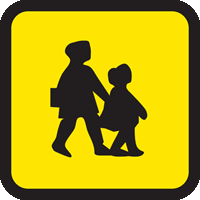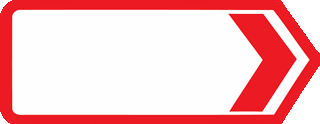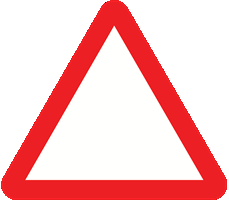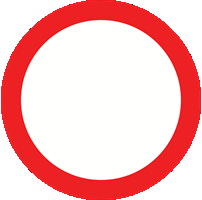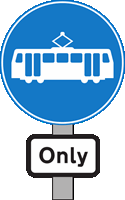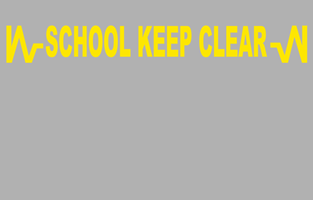You have 57 minutes to answer 50 multiple choice driving theory test questions. You need to answer at least 43 out of 50 questions correctly to pass. You can review your answer after each question or you can review all of your answers at the end of the test. Best of luck!
Test Quick View
Click on an answer to view the correct choice along with the explanation.
Correct Answer: A
Explanation: As you begin to think about overtaking, ask yourself if it's really necessary. If you can't see well ahead stay back and wait for a safer place to pull out.
Explanation: As you begin to think about overtaking, ask yourself if it's really necessary. If you can't see well ahead stay back and wait for a safer place to pull out.
جیسے ہی آپ اوورٹیک کرنے کے بارے میں سوچنا شروع کریں اپنے آپ سے پوچھیں کیا یہ کرنا واقع ضروری ہے۔اگر آپ آگے ٹھیک سے نہیں دیکھ سکتے تو پیچھے رہیں اور آگے جانے کے لئے محافظ جگہ کا انتظار کریں۔
2. You're being followed by an ambulance showing flashing blue lights. What should you do? Mark one answer
AB
C
D
Correct Answer: D
Explanation: Pull over in a place where the ambulance can pass safely. Check that there are no bollards or obstructions in the road that will prevent it from passing.
Explanation: Pull over in a place where the ambulance can pass safely. Check that there are no bollards or obstructions in the road that will prevent it from passing.
Correct Answer: B
Explanation: A green flashing beacon on a vehicle means the driver or passenger is a doctor on an emergency call. Give way to them if it's safe to do so. Be aware that the vehicle may be travelling quickly or may stop in a hurry.
Explanation: A green flashing beacon on a vehicle means the driver or passenger is a doctor on an emergency call. Give way to them if it's safe to do so. Be aware that the vehicle may be travelling quickly or may stop in a hurry.
Correct Answer: A
Explanation: Your tyres are your only contact with the road. To prevent problems with braking and steering, keep your tyres free from defects; they must have sufficient tread depth and be correctly inflated. Correct tyre pressures help reduce the risk of skidding and provide a safer and more comfortable drive or ride.
Explanation: Your tyres are your only contact with the road. To prevent problems with braking and steering, keep your tyres free from defects; they must have sufficient tread depth and be correctly inflated. Correct tyre pressures help reduce the risk of skidding and provide a safer and more comfortable drive or ride.
5. Which type of vehicle should you be ready to give way to as you approach this bridge? Mark one answer
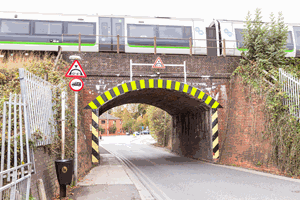
B
C
D
Correct Answer: B
Explanation: A double-deck bus or high-sided lorry will have to take a position in the centre of the road to clear the bridge. There's normally a sign to show this. Look well ahead, past the bridge and be ready to stop and give way to large oncoming vehicles.
Explanation: A double-deck bus or high-sided lorry will have to take a position in the centre of the road to clear the bridge. There's normally a sign to show this. Look well ahead, past the bridge and be ready to stop and give way to large oncoming vehicles.
Correct Answer: D
Explanation: Vehicles that are used to carry children to and from school will be travelling at busy times of the day. If you're following a vehicle with this sign, be prepared for it to make frequent stops. It might pick up or set down passengers in places other than normal bus stops.
Explanation: Vehicles that are used to carry children to and from school will be travelling at busy times of the day. If you're following a vehicle with this sign, be prepared for it to make frequent stops. It might pick up or set down passengers in places other than normal bus stops.
A
B
C
D
B
C
D
Correct Answer: B
Explanation: A long vehicle may have to straddle lanes either on or approaching a roundabout so that the rear wheels don't hit the kerb. If you're following a long vehicle, stay well back and give it plenty of room.
Explanation: A long vehicle may have to straddle lanes either on or approaching a roundabout so that the rear wheels don't hit the kerb. If you're following a long vehicle, stay well back and give it plenty of room.
Correct Answer: D
Explanation: Road signs in the shape of a circle give orders. Those with a red circle are mostly prohibitive. The 'stop' sign is octagonal to give it greater prominence. Signs giving orders must always be obeyed.
Explanation: Road signs in the shape of a circle give orders. Those with a red circle are mostly prohibitive. The 'stop' sign is octagonal to give it greater prominence. Signs giving orders must always be obeyed.
Correct Answer: D
Explanation: Avoid blocking tram routes. Trams are fixed on their route and can't manoeuvre around other vehicles or pedestrians. Modern trams travel quickly and are quiet, so you might not hear them approaching.
Explanation: Avoid blocking tram routes. Trams are fixed on their route and can't manoeuvre around other vehicles or pedestrians. Modern trams travel quickly and are quiet, so you might not hear them approaching.

B
C
D
Correct Answer: D
Explanation: When the amber light is showing on its own, the red light will follow next. The amber light means stop, unless you've already crossed the stop line or you're so close to it that stopping may cause a collision.
Explanation: When the amber light is showing on its own, the red light will follow next. The amber light means stop, unless you've already crossed the stop line or you're so close to it that stopping may cause a collision.
11. At this junction, there's a 'stop' sign and a solid white line on the road surface. Why is there a 'stop' sign here? Mark one answer
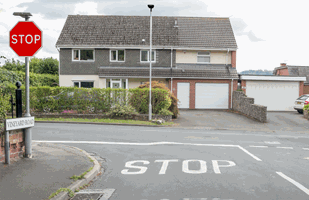
B
C
D
Correct Answer: D
Explanation: If your view at a road junction is restricted, you must stop. There may also be a 'stop' sign. Don't emerge until you're sure no traffic is approaching. If you don't know, don't go.
Explanation: If your view at a road junction is restricted, you must stop. There may also be a 'stop' sign. Don't emerge until you're sure no traffic is approaching. If you don't know, don't go.
A
B
C
D
B
C
D
Correct Answer: C
Explanation: A toucan crossing is designed to allow pedestrians and cyclists to cross at the same time. Look out for cyclists approaching the crossing at speed.
Explanation: A toucan crossing is designed to allow pedestrians and cyclists to cross at the same time. Look out for cyclists approaching the crossing at speed.
13. There are flashing amber lights under a school warning sign. What action should you take? Mark one answer
AB
C
D
Correct Answer: C
Explanation: The flashing amber lights are switched on to warn you that children may be crossing near a school. Slow down and take extra care, as you may have to stop.
Explanation: The flashing amber lights are switched on to warn you that children may be crossing near a school. Slow down and take extra care, as you may have to stop.
Correct Answer: C
Explanation: Try to plan your journey so that you can take rest stops. It's recommended that you take a break of at least 15 minutes after every two hours of driving or riding. This should help to maintain your concentration.
Explanation: Try to plan your journey so that you can take rest stops. It's recommended that you take a break of at least 15 minutes after every two hours of driving or riding. This should help to maintain your concentration.
15. You're on a motorway. What colour are the reflective studs on the left of the carriageway? Mark one answer
AB
C
D
Correct Answer: C
Explanation: Red studs are placed between the edge of the carriageway and the hard shoulder. Where slip roads leave or join the motorway, the studs are green.
Explanation: Red studs are placed between the edge of the carriageway and the hard shoulder. Where slip roads leave or join the motorway, the studs are green.
A
B
C
D
B
C
D
Correct Answer: C
Explanation: Normally you should travel in the left-hand lane and only use the right-hand lane for overtaking or turning right. Move back into the left lane as soon as it's safe but don't cut in across the path of the vehicle you've just passed.
Explanation: Normally you should travel in the left-hand lane and only use the right-hand lane for overtaking or turning right. Move back into the left lane as soon as it's safe but don't cut in across the path of the vehicle you've just passed.
Correct Answer: D
Explanation: Check your tyre pressures frequently - normally once a week. If they're lower than those recommended by the manufacturer, there will be more 'rolling resistance'. The engine will have to work harder to overcome this, leading to increased fuel consumption.
Explanation: Check your tyre pressures frequently - normally once a week. If they're lower than those recommended by the manufacturer, there will be more 'rolling resistance'. The engine will have to work harder to overcome this, leading to increased fuel consumption.
Correct Answer: C
Explanation: These markings are found on the road outside schools. Don't stop or park on them, even to set down or pick up children. The markings are there to ensure that drivers, riders, children and other pedestrians have a clear view of the road in all directions.
Explanation: These markings are found on the road outside schools. Don't stop or park on them, even to set down or pick up children. The markings are there to ensure that drivers, riders, children and other pedestrians have a clear view of the road in all directions.
19. Some two-way roads are divided into three lanes. Why are these particularly dangerous? Mark one answer
AB
C
D
Correct Answer: C
Explanation: If you intend to overtake, you must consider that approaching traffic could be planning the same manoeuvre. When you've considered the situation and decided it's safe, indicate your intentions early. This will show the approaching traffic that you intend to pull out.
Explanation: If you intend to overtake, you must consider that approaching traffic could be planning the same manoeuvre. When you've considered the situation and decided it's safe, indicate your intentions early. This will show the approaching traffic that you intend to pull out.
20. You see this amber traffic light ahead. Which light, or lights, will come on next? Mark one answer
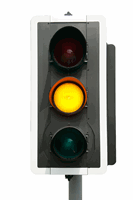
B
C
D
Correct Answer: C
Explanation: At junctions controlled by traffic lights, you must stop behind the white line until the lights change to green. A red light, an amber light, and red and amber lights showing together all mean stop. You may proceed when the light is green unless your exit road is blocked or pedestrians are crossing in front of you. If you're approaching traffic lights that are visible from a distance and the light has been green for some time, be ready to slow down and stop, because the lights are likely to change.
Explanation: At junctions controlled by traffic lights, you must stop behind the white line until the lights change to green. A red light, an amber light, and red and amber lights showing together all mean stop. You may proceed when the light is green unless your exit road is blocked or pedestrians are crossing in front of you. If you're approaching traffic lights that are visible from a distance and the light has been green for some time, be ready to slow down and stop, because the lights are likely to change.
21. What should you do when approaching traffic lights where red and amber are showing together? Mark one answer

B
C
D
Correct Answer: D
Explanation: Be aware that other traffic might still be clearing the junction as you approach. A green light means you may go on, but only if the way is clear.
Explanation: Be aware that other traffic might still be clearing the junction as you approach. A green light means you may go on, but only if the way is clear.
Correct Answer: D
Explanation: Emergency refuge areas are built at the side of the hard shoulder. If you break down, try to get your vehicle into the refuge, where there's an emergency telephone. The phone connects directly to a control centre. Remember to take care when rejoining the motorway, especially if the hard shoulder is being used as a running lane.
Explanation: Emergency refuge areas are built at the side of the hard shoulder. If you break down, try to get your vehicle into the refuge, where there's an emergency telephone. The phone connects directly to a control centre. Remember to take care when rejoining the motorway, especially if the hard shoulder is being used as a running lane.
23. Traffic officers operate on motorways and some primary routes in England. What are they authorised to do? Mark one answer
AB
C
D
Correct Answer: D
Explanation: Traffic officers don't have enforcement powers but are able to stop and direct people on motorways and some 'A' class roads. They only operate in England and work in partnership with the police at incidents, providing a highly trained and visible service. They're recognised by an orange-and-yellow jacket and their vehicle has yellow-and-black markings.
Explanation: Traffic officers don't have enforcement powers but are able to stop and direct people on motorways and some 'A' class roads. They only operate in England and work in partnership with the police at incidents, providing a highly trained and visible service. They're recognised by an orange-and-yellow jacket and their vehicle has yellow-and-black markings.
A
B
C
D
B
C
D
Correct Answer: B
Explanation: Lorry drivers can be unaware of objects falling from their vehicles. If you see something fall onto a motorway, look to see if the driver pulls over. If they don't stop, don't attempt to retrieve the object yourself. Pull onto the hard shoulder near an emergency telephone and report the hazard.
Explanation: Lorry drivers can be unaware of objects falling from their vehicles. If you see something fall onto a motorway, look to see if the driver pulls over. If they don't stop, don't attempt to retrieve the object yourself. Pull onto the hard shoulder near an emergency telephone and report the hazard.
Correct Answer: D
Explanation: If you know which light is going to show next, you can plan your approach accordingly. This can help prevent excessive braking or hesitation at the junction.
Explanation: If you know which light is going to show next, you can plan your approach accordingly. This can help prevent excessive braking or hesitation at the junction.
26. You arrive at the scene of a motorcycle crash. The rider is injured. When should their helmet be removed? Mark one answer
AB
C
D
Correct Answer: C
Explanation: Don't remove a motorcyclist's helmet unless it's essential. Remember they may be suffering from shock. Don't give them anything to eat or drink, but do reassure them confidently.
Explanation: Don't remove a motorcyclist's helmet unless it's essential. Remember they may be suffering from shock. Don't give them anything to eat or drink, but do reassure them confidently.
Correct Answer: D
Explanation: The motorcyclist is in an extremely vulnerable position, exposed to further danger from traffic. Approaching vehicles need advance warning in order to slow down and safely take avoiding action or stop. Don't put yourself or anyone else at risk. Use the hazard warning lights on your vehicle to alert other road users to the danger.
Explanation: The motorcyclist is in an extremely vulnerable position, exposed to further danger from traffic. Approaching vehicles need advance warning in order to slow down and safely take avoiding action or stop. Don't put yourself or anyone else at risk. Use the hazard warning lights on your vehicle to alert other road users to the danger.
A
B
C
D
B
C
D
Correct Answer: D
Explanation: If there's nothing in the wound, applying a pad of clean cloth or bandage will help stem the bleeding. Raising the leg will also lessen the flow of blood. Don't tie anything tightly round the leg, as this will restrict circulation and could result in long-term injury.
Explanation: If there's nothing in the wound, applying a pad of clean cloth or bandage will help stem the bleeding. Raising the leg will also lessen the flow of blood. Don't tie anything tightly round the leg, as this will restrict circulation and could result in long-term injury.
29. You've just passed your test. How can you reduce your risk of being involved in a collision? Mark one answer
AB
C
D
Correct Answer: D
Explanation: New drivers and riders are often involved in a collision or incident early in their driving career. Due to a lack of experience, they may not react to hazards appropriately. Approved training courses are offered by driver and rider training schools for people who have passed their test but want extra training.
Explanation: New drivers and riders are often involved in a collision or incident early in their driving career. Due to a lack of experience, they may not react to hazards appropriately. Approved training courses are offered by driver and rider training schools for people who have passed their test but want extra training.
30. You're on a long motorway journey. What should you do if you start to feel sleepy? Mark one answer
AB
C
D
Correct Answer: B
Explanation: If you feel sleepy, you should leave the motorway at a service area or at the next exit and stop in a safe place to rest. A supply of fresh air can help to keep you alert before you reach the exit, but it isn't a substitute for stopping and resting.
Explanation: If you feel sleepy, you should leave the motorway at a service area or at the next exit and stop in a safe place to rest. A supply of fresh air can help to keep you alert before you reach the exit, but it isn't a substitute for stopping and resting.
Correct Answer: D
Explanation: Consult the vehicle handbook or a garage before driving the vehicle any further. Only drive to a garage if it's safe to do so. If you aren't sure, get expert help.
Explanation: Consult the vehicle handbook or a garage before driving the vehicle any further. Only drive to a garage if it's safe to do so. If you aren't sure, get expert help.
Correct Answer: C
Explanation: When you're going to drive, make sure that you're wearing suitable clothing. Comfortable shoes will ensure that you have proper control of the foot pedals.
Explanation: When you're going to drive, make sure that you're wearing suitable clothing. Comfortable shoes will ensure that you have proper control of the foot pedals.
Correct Answer: B
Explanation: Be courteous and allow the traffic to merge into the left-hand lane.
Explanation: Be courteous and allow the traffic to merge into the left-hand lane.
A
B
C
D
B
C
D
Correct Answer: D
Explanation: At a pelican crossing, the green light means you may proceed as long as the crossing is clear. If someone hasn't finished crossing, be patient and wait for them, whether they're disabled or not.
Explanation: At a pelican crossing, the green light means you may proceed as long as the crossing is clear. If someone hasn't finished crossing, be patient and wait for them, whether they're disabled or not.
35. You're driving in town. Ahead of you a bus is at a bus stop. Which of the following should you do? Mark one answer
AB
C
D
Correct Answer: D
Explanation: As you approach, look out for any signal the driver might make. If you pass the vehicle, watch out for pedestrians attempting to cross the road from behind the bus. They'll be hidden from view until the last moment.
Explanation: As you approach, look out for any signal the driver might make. If you pass the vehicle, watch out for pedestrians attempting to cross the road from behind the bus. They'll be hidden from view until the last moment.
Correct Answer: A
Explanation: Rapid acceleration and heavy braking lead to increased
- fuel consumption
- wear on your vehicle.
Having your vehicle serviced regularly will maintain its efficiency, produce cleaner emissions and reduce the risk of a breakdown.
Explanation: Rapid acceleration and heavy braking lead to increased
- fuel consumption
- wear on your vehicle.
Having your vehicle serviced regularly will maintain its efficiency, produce cleaner emissions and reduce the risk of a breakdown.
37. You've stalled in the middle of a level crossing and can't restart the engine. The warning bells start to ring. What should you do? Mark one answer
AB
C
D
Correct Answer: B
Explanation: Try to stay calm, especially if you have passengers with you. If you can't restart your engine before the warning bells ring, leave the vehicle and get yourself and any passengers well clear of the crossing.
Explanation: Try to stay calm, especially if you have passengers with you. If you can't restart your engine before the warning bells ring, leave the vehicle and get yourself and any passengers well clear of the crossing.
Correct Answer: A
Explanation: Before moving off, you should use both the interior and exterior mirrors to check that the road is clear. Look around to check the blind spots and, if necessary, give a signal to warn other road users of your intentions.
Explanation: Before moving off, you should use both the interior and exterior mirrors to check that the road is clear. Look around to check the blind spots and, if necessary, give a signal to warn other road users of your intentions.
39. You're driving on an icy road. What distance from the car in front should you drive? Mark one answer
AB
C
D
Correct Answer: D
Explanation: Don't travel in icy or snowy weather unless your journey is essential. Drive extremely carefully when roads are or may be icy. Stopping distances can be ten times greater than on dry roads.
Explanation: Don't travel in icy or snowy weather unless your journey is essential. Drive extremely carefully when roads are or may be icy. Stopping distances can be ten times greater than on dry roads.
40. Daytime visibility is poor but not seriously reduced. Which lights should you switch on? Mark one answer
AB
C
D
Correct Answer: A
Explanation: Only use your fog lights when visibility is seriously reduced. Use dipped headlights in poor conditions because this helps other road users to see you without the risk of causing dazzle.
Explanation: Only use your fog lights when visibility is seriously reduced. Use dipped headlights in poor conditions because this helps other road users to see you without the risk of causing dazzle.
Correct Answer: A
Explanation: Rear fog lights make it easier to spot a vehicle ahead in foggy conditions. Avoid the temptation to use other vehicles' lights as a guide, as they may give you a false sense of security.
Explanation: Rear fog lights make it easier to spot a vehicle ahead in foggy conditions. Avoid the temptation to use other vehicles' lights as a guide, as they may give you a false sense of security.
Correct Answer: B
Explanation: Whenever possible, leave your car in a secure car park. This will help deter thieves.
Explanation: Whenever possible, leave your car in a secure car park. This will help deter thieves.
Correct Answer: D
Explanation: Diesel fuel can spill out if your filler cap isn't secured properly. This is most likely to occur on bends, junctions and roundabouts, where it will make the road slippery, especially if it's wet. At the end of a dry spell of weather, the road surfaces may have a high level of diesel spillage that hasn't been washed away by rain.
Explanation: Diesel fuel can spill out if your filler cap isn't secured properly. This is most likely to occur on bends, junctions and roundabouts, where it will make the road slippery, especially if it's wet. At the end of a dry spell of weather, the road surfaces may have a high level of diesel spillage that hasn't been washed away by rain.
Correct Answer: A
Explanation: A security-coded radio can deter thieves, as it's likely to be of little use when removed from the vehicle.
Explanation: A security-coded radio can deter thieves, as it's likely to be of little use when removed from the vehicle.
Correct Answer: D
Explanation: The vehicle watch scheme helps to reduce the risk of your car being stolen. By displaying high-visibility vehicle watch stickers in your car, you're inviting the police to stop your vehicle if it's seen in use between midnight and 5 am.
Explanation: The vehicle watch scheme helps to reduce the risk of your car being stolen. By displaying high-visibility vehicle watch stickers in your car, you're inviting the police to stop your vehicle if it's seen in use between midnight and 5 am.
Correct Answer: C
Explanation: If you have ABS and need to stop in an emergency, keep your foot firmly on the brake pedal until the vehicle has stopped. When the ABS operates, you may hear a grating sound and feel vibration through the brake pedal. This is normal and you should maintain pressure on the brake pedal until the vehicle stops.
Explanation: If you have ABS and need to stop in an emergency, keep your foot firmly on the brake pedal until the vehicle has stopped. When the ABS operates, you may hear a grating sound and feel vibration through the brake pedal. This is normal and you should maintain pressure on the brake pedal until the vehicle stops.
47. Your vehicle breaks down on the hard shoulder of a motorway. You need to use your mobile phone to call for help. What should you do? Mark one answer
AB
C
D
Correct Answer: A
Explanation: You should use an emergency telephone when you break down on the motorway; only use your mobile if this isn't possible. The emergency services need to know your exact location so they can reach you as quickly as possible. Look for a number on the nearest marker post beside the hard shoulder. Give this number when you call the emergency services.
Explanation: You should use an emergency telephone when you break down on the motorway; only use your mobile if this isn't possible. The emergency services need to know your exact location so they can reach you as quickly as possible. Look for a number on the nearest marker post beside the hard shoulder. Give this number when you call the emergency services.
Correct Answer: B
Explanation: Whenever possible, park in an area that will be well lit at night.
Explanation: Whenever possible, park in an area that will be well lit at night.
A
B
C
D
B
C
D
Correct Answer: C
Explanation: New drivers are far more vulnerable on the road and more likely to be involved in incidents. The Pass Plus scheme has been designed to improve new drivers' basic skills and help widen their driving experience.
Explanation: New drivers are far more vulnerable on the road and more likely to be involved in incidents. The Pass Plus scheme has been designed to improve new drivers' basic skills and help widen their driving experience.
50. You're parked at the side of the road. You'll be waiting some time for a passenger. What should you do? Mark one answer
AB
C
D
Correct Answer: B
Explanation: If your vehicle is stationary and is likely to remain so for some time, switch off the engine. We should all try to reduce global warming and pollution.
Explanation: If your vehicle is stationary and is likely to remain so for some time, switch off the engine. We should all try to reduce global warming and pollution.



